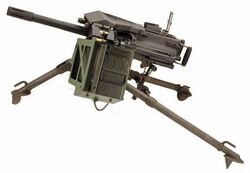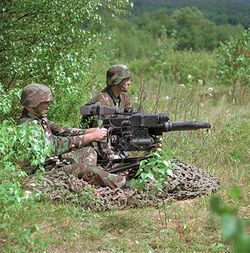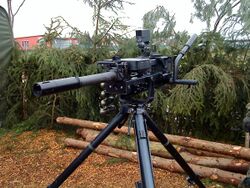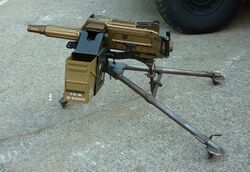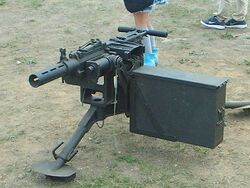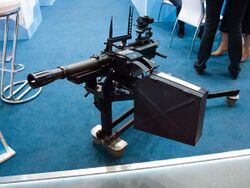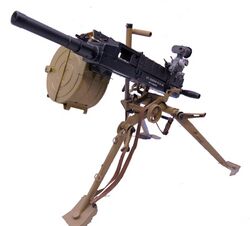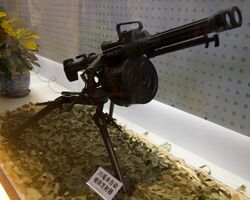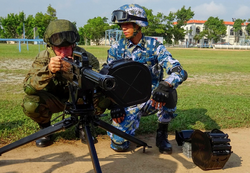Automatic grenade launcher
Topic: Engineering
 From HandWiki - Reading time: 6 min
From HandWiki - Reading time: 6 min
An automatic grenade launcher (AGL) or grenade machine gun is a grenade launcher that is capable of fully automatic fire,[1] and is typically loaded with either an ammunition belt or magazine.[2][3][4][5]
These weapons are often mounted on vehicles or helicopters, as when these weapons are moved by infantry the weapon, its tripod, and ammunition, are a heavy load, requiring a small team.[2] Other types of grenade launchers are typically much lighter and can easily be carried by just a single soldier. The Mark 19 Automatic Grenade Launcher, first fielded by the United States in 1966, and still widely used today, weighs 62.5 kg (137.58 lb) when attached to its tripod, and loaded with a box of ammunition.[3] For comparison, the single-shot M79 grenade launcher weighs 2.93 kg (6.45 lb). Regardless of their weight, AGLs are still highly effective, and the Mark 19 is capable of indirect fire up to 2,200 metres, a role traditionally reserved for mortars. Even though the round carries less explosive than a 60mm mortar shell, this is thought to be counterbalanced by its much higher volume of fire.
The most popular caliber for automatic grenade launchers in Western nations has been 40mm.[2][3] The Soviet Union successfully fielded a 30mm grenade launcher, the AGS-17, during its war in Afghanistan. In 2002, Russia introduced a successor weapon, the AGS-30, and in 2017, the AGS-40 Balkan.[6] Traditional munitions for automatic grenade launchers include high explosive, fragmentation, and shaped charge for attacking light armored vehicles. Less lethal rounds, like tear gas and sponge grenades for crowd control, have also been made. In the 21st century, AGLs have been made with integrated sight/range systems which can set a fused round to detonate precisely on, above, or behind a designated target.[6][7]
Different weapons use different methods of operation, with blowback and long recoil being two common choices.[2] In all these weapons, the energy released by firing a round loads the next round into the weapon's breech. The Mark 19 is automatically reloaded through the blowback method, where expanding gases blow back the firing bolt.
In the long recoil method the bolt is fixed to the firing chamber, and the whole firing chamber is blown back. These weapons are slightly less accurate, but weigh less than blowback weapons.[8] General Dynamics manufactures a long recoil weapon, the Mark 47 Automatic Grenade Launcher, as does the Spanish firm Santa Bárbara. The LAG-40 manufactured by Santa Bárbara has a relatively low rate of fire of 215 rounds per minute.
Comparison
| Name | Country | Year | Image | Caliber | Effective Range | Muzzle velocity |
Rate of fire, rpm |
Approx. weight[upper-alpha 1] |
Feed, rounds |
Sights[upper-alpha 2] |
|---|---|---|---|---|---|---|---|---|---|---|
| Mk 19 Mod 3 [9] |
1966 | 40×53mm | 1,500 m (4,900 ft) | 241 m/s (790 ft/s) | 325‑375 | 35.2 kg (78 lb) | Belt, 32, 48 | Night vision | ||
| AGS-17 | 1967 | 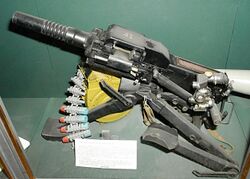
|
30×29mm grenade | 1,700 m | 185 m/s | 400 | — | — | — | |
| Mk 47 Striker [10] |
2005 | 40x53mm | 1,700 m (5,600 ft) | — | 225‑300 | 18 kg (40 lb) | Belt, 32, 48 | FCS, Thermal | ||
| HK GMG [11] |
1992 | 40x53mm | 1,500 m (4,900 ft) | 241 m/s (790 ft/s) | 340 | 29 kg (64 lb) | Belt, 32 | Reflex, "Various" | ||
| SB-40 LAG [citation needed] |
1984 | 40x53mm | 1,500 m (4,900 ft) | 240 m/s (790 ft/s) | 215 | 34 kg (75 lb) | Belt, 24, 32 | Night vision | ||
| STK 40 AGL [12] |
1986 | 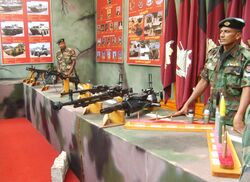
|
40x53mm | 1,500 m (4,900 ft) | 242 m/s (790 ft/s) | 350‑500 | 33 kg[13] | Belt, 32 | Reflex, FCS, Thermal | |
| Daewoo K4 [14] |
1985 | 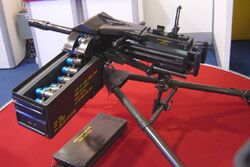
|
40x53mm | 1,500 m (4,900 ft) | 241 m/s (790 ft/s) | 325-375 | 34.4 kg (76 lb) | Belt, 24, 48 | KAN/TVS-5 night vision scope can be attached | |
| Howa Type 96 [15] |
1996 | 40x53mm | 1,500 m (4,900 ft) | — | 250‑350 | 24.5 kg (54 lb) | Belt, 50 | Ladder sights | ||
| Denel Y3 AGL [16] |
1992 | 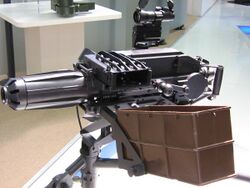
|
40x53mm | 2,176 m
(7,100 ft) |
242 m/s (790 ft/s) | 280‑320 | 53 kg (117 lb) | Belt, 20 | Optical, Indirect electronic sight | |
| UAG-40 [17] |
2016 | 40x53mm | — | 240 m/s (790 ft/s) | 400 | 31 kg (68 lb) | Belt, 32 | Optical, Infrared, Photo‑Visual, Electronic[18] | ||
| AGA-40 Md.85 [19][upper-alpha 3] |
1985 | 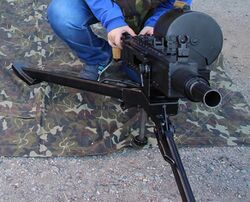
|
40x74.5mm | 1,400 m (4,600 ft) | 216 m/s (710 ft/s) | 380‑450 | 33 kg (73 lb) | Mag., 10 | — | |
| AGS‑30 Atlant [20][21][22] |
1990 | 30x29mm | 2,100 m
(6,900 ft) |
185 m/s (610 ft/s) | 400 | 17.5 kg (39 lb) | Belt, 29 | Optical, Day‑Night, Radar sight | ||
| AGS‑40 Balkan [23][24] |
2017 | 40x53mm (caseless) |
2,500 m
(8,200 ft) |
— | 400 | 32 kg (71 lb) | Belt, 20 | Optical | ||
| Type 87 [upper-alpha 4][25] |
1987 | 35x32mm | 1,700 m (5,600 ft) | 200 m/s (660 ft/s) | 500 | 12 kg (26 lb)/20 kg (44 lb) | Mag., 6, 9, 12, 15 | Optical | ||
| Type 04 [26] |
2004 | 35x32mm | 1,750 m (5,740 ft) | 200 m/s (660 ft/s) | 350-400 | 20 kg (44 lb) | Belt, 30 | Optical |
Ammunition
| 40×74.5mm [19] | 30×29mm | 40mm "Balkan" | 35×32mm [25] | ||||
|---|---|---|---|---|---|---|---|
| HE | HEAT | VOG-30 [27][28] | GPD-30 [22][29] | 7P39 [24][30] | HE | HEAT | |
| Max. range | 1,550 m (5,090 ft) | 1,700 m (5,600 ft) | 2,100 m (6,900 ft) | 2,500 m (8,200 ft) | 1,750 m (5,740 ft) | ||
| Muzzle velocity | 223 m/s (730 ft/s) | 185 m/s (610 ft/s) | — | 200 m/s (660 ft/s) | |||
| Weight | 490 g (1.08 lb) | 348 g (0.767 lb) | 340 g (0.75 lb) | 430 g (0.95 lb) | — | — | |
| Shell weight | 260 g (0.57 lb) | 275 g (0.606 lb) | — | — | — | ||
| Filling | — | — | 47 g (1.7 oz) | — | 90 g (3.2 oz) | — | — |
| Kill radius/area | 10 m (33 ft) | — | 90 m2 (970 sq ft) | 120 m2 (1,300 sq ft) | — | — | — |
| Penetration | — | 50 mm (2.0 in) | — | — | — | — | 80 mm (3.1 in) |
See also
References
- ↑ "GRENADE LAUNCHERS AND THEIR AMMUNITION: INTERNATIONAL DEVELOPMENTS". http://www.sadefensejournal.com/wp/?p=2944.
- ↑ 2.0 2.1 2.2 2.3 "CASW (Close Area Suppression Weapon System) Automatic Grenade Launcher — MERX Notice of Proposed Procurement". Canadian American Strategic Review. August 2009. http://www.casr.ca/doc-npp-casw-agl.htm.
- ↑ 3.0 3.1 3.2 "Background – CASW Project – Company Area Suppression Weapon". Canadian American Strategic Review. December 2008. http://casr.ca/bg-casw2.htm. "In its current form, the Mk19 mod 3, this AGL has become the weapon of choice among US ground troops in Iraq – primarily because the AGL offers both direct (to 1,600 meters) and indirect fire (to 2,200 meters)."
- ↑ Spencer C. Tucker (20 May 2011). The Encyclopedia of the Vietnam War: A Political, Social, and Military History. ABC-CLIO. p. 431. ISBN 978-1-85109-961-0. https://books.google.com/books?id=qh5lffww-KsC&pg=PA431. Retrieved 17 October 2016.
- ↑ Dennis J. Blasko (17 June 2013). The Chinese Army Today: Tradition and Transformation for the 21st Century. Routledge. p. 168. ISBN 978-1-136-51997-0. https://books.google.com/books?id=G1SauJF3GqwC&pg=PA168. Retrieved 17 October 2016.
- ↑ 6.0 6.1 "A new generation of AGLs". Armada International. 2002-04-01. http://www.thefreelibrary.com/A+new+generation+of+AGLs%3A+within+only+a+few+decades+the+Automatic...-a086195789.
- ↑ Us Future Combat & Weapon Systems Handbook. International Business Publications. 30 March 2009. p. 265. ISBN 978-1-4387-5447-5. https://books.google.com/books?id=lPmVrgeVoI0C&pg=PA265. Retrieved 17 October 2016.
- ↑ "Background — CASW Candidates Operating Systems – Long Recoil". Canadian American Strategic Review. December 2008. http://casr.ca/bg-casw2.htm. "The long recoil operating system’s obvious advantage is the compact gun body. While this compensates for the weapon’s internal complications, that moving barrel might also result in first-round aiming inaccuracies. The AGL designers are willing to overlook this in exchange for reduced weight (in comparison to a blowback design) and for the portability inherent in a smaller weapon (even if weight reduction is modest). In any case, great accuracy is not the forte of the AGLs."
- ↑ [1] [|permanent dead link|dead link}}]
- ↑ "Mk47 Striker40: GD's Auto-Programmed 40mm GMG". Defense Industry Daily. 9 August 2010. http://www.defenseindustrydaily.com/Mk47-Striker40-GDs-Auto-Programmed-40mm-GMG-06508/.
- ↑ "Heckler & Koch :: Home". Heckler-koch.com. https://www.heckler-koch.com/en/products/military/40-mm-systems/gmg/gmg/technical-data.html.
- ↑ "CIS 40AGL". Stengg.com. http://www.stengg.com/download/pdf/1120s5um8ejb7cbtsoun.pdf.
- ↑ "ST Kinetics (CIS) 40 AGL". https://www.militaryfactory.com/smallarms/detail.asp?smallarms_id=1161.
- ↑ "Defense Products - S&T Motiv". S&T Motiv. http://www.sntmotiv.com/eng/business/data/defence_catalog.pdf.
- ↑ "96 formula 40 mm automatic gun gun". via wayback machine. 6 January 2009. http://rightwing.sakura.ne.jp/equipment/jgsdf/infantry/type96grenade-launcher/type96grenade-launcher.html.
- ↑ "40 ml Y3 AGL". Iieexport.com. http://www.iieexport.com/files/AGLBROCHURE2.pdf.
- ↑ "Leninska Kuznya Plant Joint Stock Co.". Lk.com.au. http://www.lk.com.ua/specials/armament/grenadelauncher-uag40.php?lang=en.
- ↑ "мотреть Український автоматичний гранатомет УАГ-40 онлайн". Video.i.ua. http://video.i.ua/user/3871267/58517/331547/.
- ↑ 19.0 19.1 "Arme uitate". Romania Military. 15 December 2011. https://www.rumaniamilitary.ro/arme-uitate-2.
- ↑ "AGS-30". http://kbptula.ru/index.php?option=com_content&view=article&id=132&Itemid=443&lang=en.
- ↑ "Open Joint Stock Company "V.A.Degtyarev Plant" / AGS-30 30 mm antipersonnel automatic grenade launching system". Kbptula.ru. http://zid.ru/eng/products/47/detail/228.
- ↑ 22.0 22.1 "ГПД-30, 30 мм гранатометный выстрел". http://www.arms-expo.ru/056051054057124050056057052055.html.
- ↑ "Military Defense Industry Technology - AGS-40 Balkan". https://www.armyrecognition.com/weapons_defence_industry_military_technology_uk/new_ags-40_balkan_40mm_automatic_grenade_launcher_will_enter_in_service_with_russian_army_tass_11311161.html.
- ↑ 24.0 24.1 "Lenta.ru: Оружие: Вооружение: Россия вооружится новым крупнокалиберным гранатометом" (in ru). Lenta.ru. http://lenta.ru/news/2013/02/18/balkan/.
- ↑ 25.0 25.1 "QLZ87 35mm Automatic Grenade Launcher". http://www.sinodefence.com/army/crewserved/qlz87.asp.
- ↑ "QLZ-04". https://weaponsystems.net/system/1020-BB02%20-%20QLZ04.
- ↑ "Выстрел ВОГ-17 (ВОГ-17А) / ВОГ-17М / ВОГ-30 / ГПД-30". Weapon.at.au. http://weapon.at.ua/board/25-1-0-46.
- ↑ "Error: no
|title=specified when using {{Cite web}}" (in ru). E-reading-lib.org. http://www.e-reading-lib.org/bookreader.php/149125/Fedoseev_-_Boevoe_strelkovoe_oruzhie_Rossii.html. - ↑ "ГПД-30". http://www.tulatskib.ru/patr_pdf/GPD30.pdf.
- ↑ "IDEX 2019: Tecmash unveils AGS-40 grenade launcher - EDR Magazine". 20 February 2019. https://www.edrmagazine.eu/idex-2019-tecmash-unveils-ags-40-grenade-launcher.
 |
 KSF
KSF